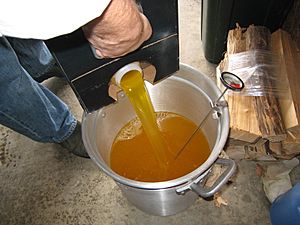Peanut oil facts for kids
Peanut oil, also known as groundnut oil, is a vegetable oil that comes from peanuts. This oil usually has a mild or neutral taste. However, if it's made from roasted peanuts, it will have a stronger peanut flavor and smell. People often use peanut oil in American, Chinese, Indian, African, and Southeast Asian cooking. It's used for everyday cooking and, if roasted, for extra flavor. Peanut oil can get very hot before it starts to smoke. This high smoke point makes it great for frying foods.
Contents
A Brief History of Peanut Oil
During World War II, there was a shortage of other cooking oils. Because peanut oil was easy to get, people in the United States started using it more often.
Where Peanut Oil Comes From
Many countries around the world produce peanut oil. Here's a look at some of the top producers in 2018:
| Country | Production, 2018 (tonnes) |
|||
|---|---|---|---|---|
| 1 | 1,821,000 | |||
| 2 | 1,540,976 | |||
| 3 | 364,100 | |||
| 4 | 252,465 | |||
| 5 | 177,800 | |||
| 6 | 175,900 | |||
| 7 | 110,000 | |||
| 8 | 102,700 | |||
| 9 | 97,000 | |||
| 10 | 70,218 | |||
| 11 | 64,000 | |||
| 12 | 63,600 | |||
| Source : FAOSTAT | ||||
How Peanut Oil is Used
Peanut oil has many uses, especially in the kitchen.
Cooking with Peanut Oil
Unrefined peanut oil is used to add flavor to dishes, much like sesame oil. Refined peanut oil is often used for frying large amounts of food, like French fries. It has a high smoke point of about 450°F (232°C). This means it can get very hot without burning.
Peanut Oil as Fuel
At a big exhibition in Paris in 1900, a company showed something amazing. They proved that peanut oil could be used as fuel for a diesel engine. This was one of the first times people saw how biodiesel technology could work.
Other Cool Uses
Just like other vegetable oils, peanut oil can be used to make soap. This process is called saponification. Peanut oil is also safe to use as a massage oil.
What's Inside Peanut Oil?
Peanut oil is made up of different kinds of fats. These include saturated fat, monounsaturated fat, and polyunsaturated fat.
Nutrients in Peanut Oil
| Nutritional value per 100 g (3.5 oz) | |
|---|---|
| Energy | 3,699 kJ (884 kcal) |
|
0 g
|
|
|
100 g
|
|
| Saturated | 17 g |
| Monounsaturated | 46 g |
| Polyunsaturated | 32 g |
|
Protein
|
0 g
|
| Vitamins | Quantity
%DV†
|
| Vitamin E |
105%
15.7 mg |
| Minerals | Quantity
%DV†
|
| Zinc |
0%
0.01 mg |
| Other constituents | Quantity |
| Cholesterol | 0 mg |
| Selenium | 0.0 mcg |
|
Fat percentage can vary.
|
|
| †Percentages estimated using US recommendations for adults. | |
Peanut oil contains about 17% saturated fat, 46% monounsaturated fat, and 32% polyunsaturated fat.
| Type of fat | Total fat (g) | Saturated fat (g) | Monounsaturated fat (g) | Polyunsaturated fat (g) | Smoke point |
|---|---|---|---|---|---|
| Butter | 80-88 | 43-48 | 15-19 | 2-3 | 150 °C (302 °F) |
| Canola oil | 100 | 6-7 | 62-64 | 24-26 | 205 °C (401 °F) |
| Coconut oil | 99 | 83 | 6 | 2 | 177 °C (351 °F) |
| Corn oil | 100 | 13-14 | 27-29 | 52-54 | 230 °C (446 °F) |
| Lard | 100 | 39 | 45 | 11 | 190 °C (374 °F) |
| Peanut oil | 100 | 17 | 46 | 32 | 225 °C (437 °F) |
| Olive oil | 100 | 13-19 | 59-74 | 6-16 | 190 °C (374 °F) |
| Rice bran oil | 100 | 25 | 38 | 37 | 250 °C (482 °F) |
| Soybean oil | 100 | 15 | 22 | 57-58 | 257 °C (495 °F) |
| Suet | 94 | 52 | 32 | 3 | 200 °C (392 °F) |
| Ghee | 99 | 62 | 29 | 4 | 204 °C (399 °F) |
| Sunflower oil | 100 | 10 | 20 | 66 | 225 °C (437 °F) |
| Sunflower oil (high oleic) | 100 | 12 | 84 | 4 | |
| Vegetable shortening | 100 | 25 | 41 | 28 | 165 °C (329 °F) |
See also
 In Spanish: Aceite de cacahuete para niños
In Spanish: Aceite de cacahuete para niños


